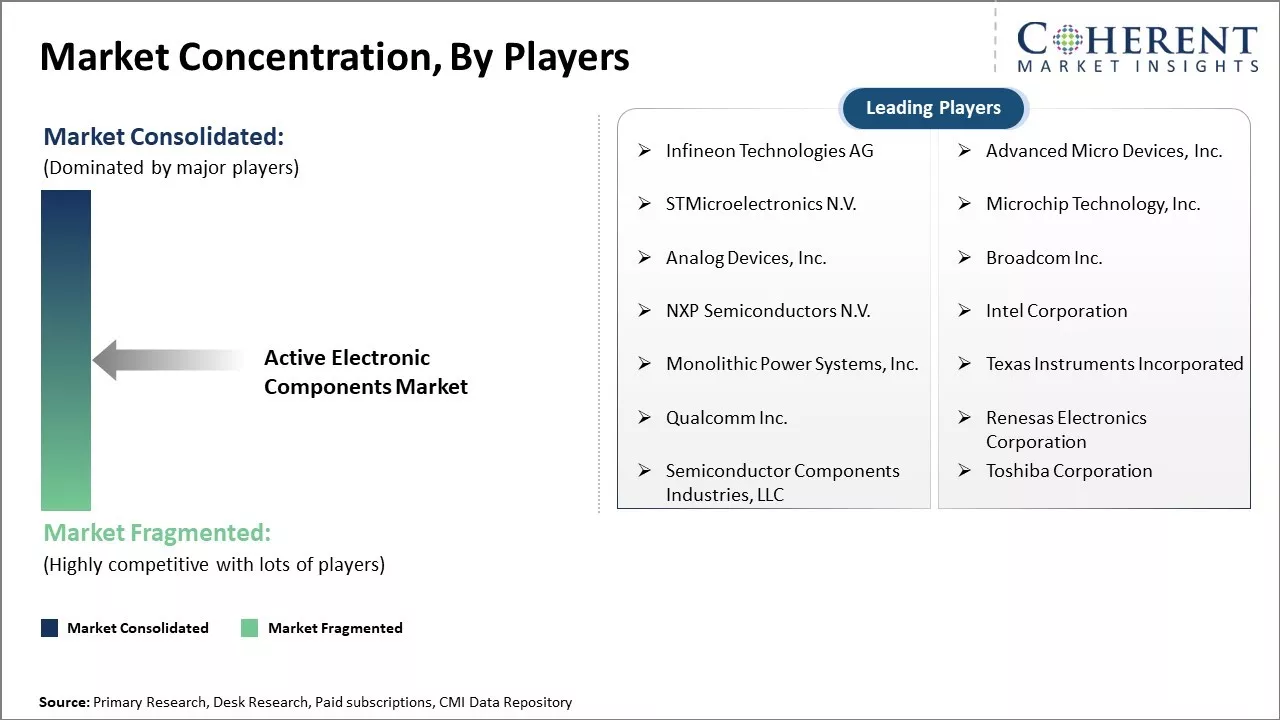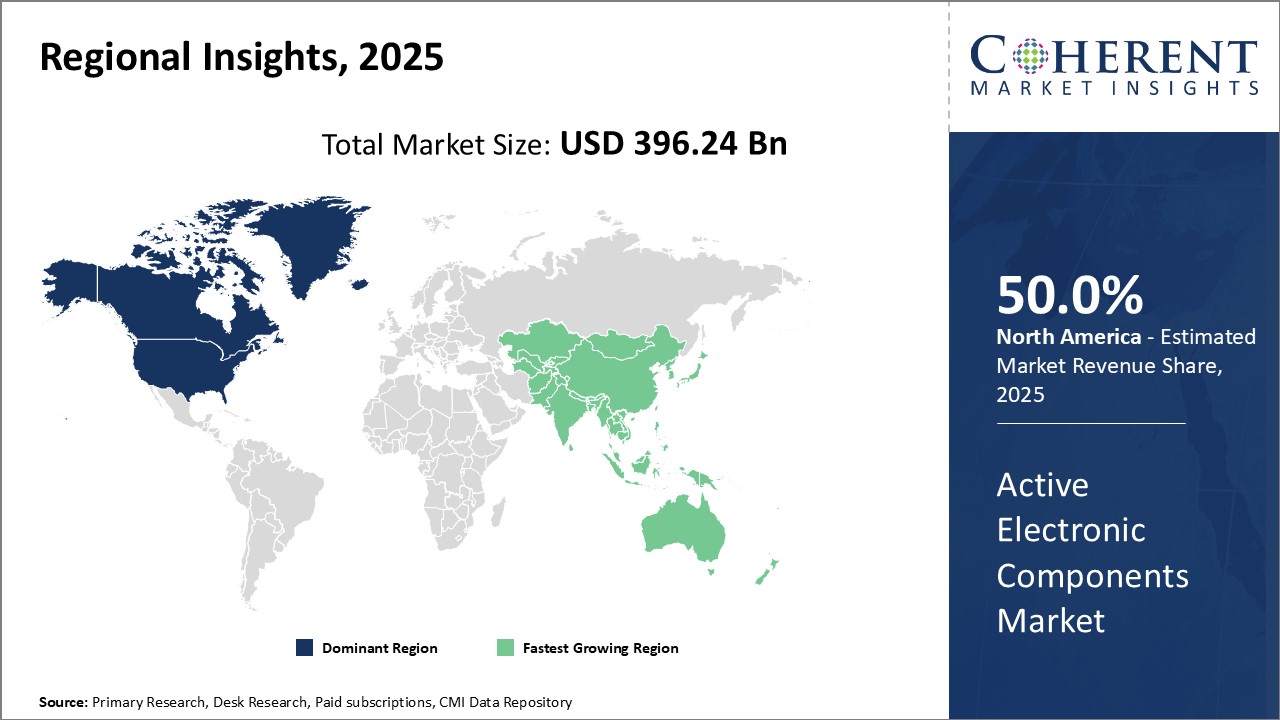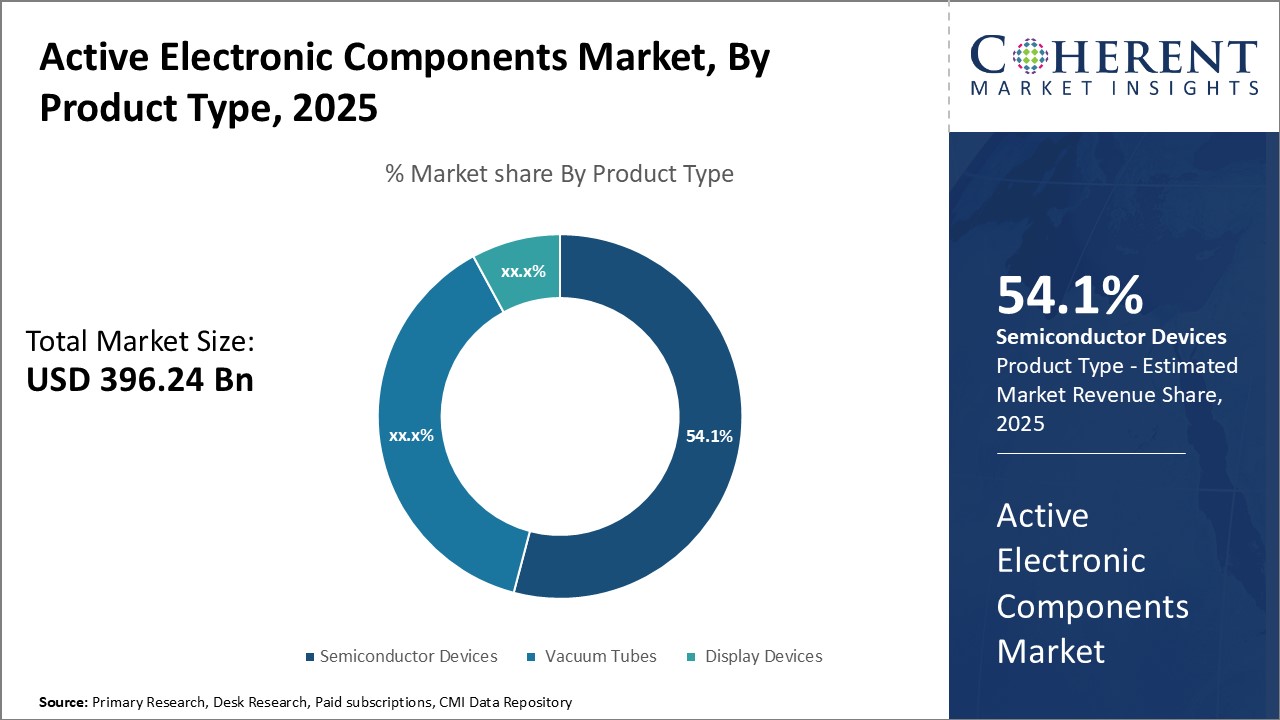Active Electronic Components Market Size and Forecast – 2025-2032
The Active Electronic Components Market is estimated to be valued at USD 396.24 Bn in 2025 and is expected to reach USD 729.48 Bn by 2032, exhibiting a compound annual growth rate (CAGR) of 9.1% from 2025 to 2032.

To learn more about this report, Download Free Sample
Key Takeaways
- Based on product type, the semiconductor device segment is expected to dominate the market holding a share of 54.1% in 2025, owing to their ability to control and amplify electrical signals.
- Based on end-users, the consumer electronic segment is expected to dominate the global market by 29.6% share in 2025, due to the increasing demand for devices such as smartphones, tablets, and laptops.
- Based on region, North America is estimated to lead the market with a share of 50.0% in 2025, due to the presence of major industry players and advanced technologies.
Market Overview
The market is expected to witness positive growth over the forecast period. Smart technologies and IoT applications are expected to drive the demand for active electronic components. Emerging sectors such as electric vehicles and renewable energy are further expected to open new avenues for market growth. Semiconductor shortages experienced during the pandemic temporarily disrupted the supply chain, however, investments in capacity expansions are expected to smoothen supply over the coming years. Rising demand from applications in data centers, consumer electronics and automotive coupled with government support for semiconductor manufacturing are expected to provide opportunities for sustainable market expansion.
Current Events and Their Impact on the Active Electronic Components Market
|
Current Events |
Description and its impact |
|
Geopolitical Tensions in Semiconductor Supply Chains
|
|
|
5G Infrastructure Acceleration
|
|
Uncover macros and micros vetted on 75+ parameters: Get instant access to report
Role of Artificial Intelligence (AI) in Active Electronic Components Market
Integration of artificial intelligence (AI) into active electronic components has contributed to the development of the Internet of Things, 5G technology, and advances in electronic devices. A well-equipped AI elevates a specialized range of electronic components from Integrated Circuits (ICs) to resistors, capacitors, transistors, and diodes. They offer efficiency, speed, and reliability of these components, along with enhancing the device functionality and user experience enabling features such as voice and facial recognition, predictive maintenance, and efficient energy management within a wide range of devices from smartphones to industry machinery.
In April 2025, Cybord, the leading company of advanced AI-powered electronic component analytics, launched its ShieldScan, an advanced visual-AI printed circuit board assembly (PCBA) inspection solution that delivers unprecedented visibility and security in electronics manufacturing.
Market Concentration and Competitive Landscape

To learn more about this report, Download Free Sample
Active Electronic Components Market Size and Trends
Growing Demand for Smart Electronics
The demand for advanced smart electronic devices has been rapidly increasing over the past few years. With the growing capabilities of semiconductors and electronic components, manufacturers have been able to develop a wide variety of smart devices with novel features and functionalities. Smartphones have become vastly more intelligent compared to early cellular phones, featuring powerful processors, advanced displays, high-resolution cameras, and a whole host of sensors. Consumer electronics such as smart TVs, wearables, and smart home appliances now have extensive connectivity and automated functionalities. For instance, In March 2025, Samsung Electronics America launched its 2025 Neo QLED 8K and 4K TV series, featuring stunning visuals and immersive sound. The new models include Samsung Vision AI for smarter, adaptive features, glare-free technology for clear 8K visuals in any lighting, and the Wireless One Connect Box for easy installation and connectivity, transmitting inputs up to 30 feet away, thereby accelerating the active electronic components market share.
Active Electronic Components Market Driver: Surging demand for Smart Manufacturing and robotics in industries
The growing demanding of for smart manufacturing and robotics is expanding the market growth. Electronic components are proven to be crucial in smart manufacturing to provide data collection, communication, and automation. This ultimately results in efficiency and productivity improvement. It facilitates real-time monitoring processes, machine health, and material flow, and offers predictive maintenance and optimization.
In the context of robotics, electronic components are the core infrastructure system of a robot, enabling senses, process, and act. They are used in circuits, sensors, actuators, and control systems to allow robots to move, interact with their environment, and perform tasks.
The market is expected to have a constant growth towards smart manufacturing and robotics as the industries are shifting towards Industry 4.0, demanding advanced, reliable electronic components with innovation and operations transformation worldwide.
Active Electronic Components Market Restraints: Competitive Pressures
The active electronic components market faces challenges from an influx of cheaper generic products from Asian manufacturers. Major brands must constantly innovate to maintain an advantage over these lower-cost competitors. The rapid changes in consumer technology also require staying ahead of the latest trends to design components for emerging devices.
Active Electronic Components Market Opportunity: Expanding Demand for IoT
The growing "Internet of Things" provides a major opportunity for the active electronic components market. As more everyday objects become smart and connected, they need advanced internal components like sensors, processors, and wireless chips. This rapid expansion into new product categories means active component producers can tap into expanding demand from many industries adopting IoT technologies.
Active Electronic Components Market Insights, By Product Type - Semiconductor Devices Powering Innovation in Electronics
Semiconductor devices contribute the largest share of 54.1% of the active electronic components market due to their widespread and diverse applications across industries. Semiconductors form the core technology that has enabled innovations from computers to smartphones to advanced manufacturing equipment. As electronics become increasingly integrated into everyday products and industrial processes, the demand for semiconductor devices continues to grow steadily.
A key driver of the semiconductor devices segment is the constant push for faster, smaller, and more powerful chips. Manufacturers are relentlessly working to pack more transistors onto integrated circuits following Moore's Law, allowing for new generations of more capable processors, memory, and logic chips. Miniaturization has fostered rapid growth in portable electronics like smartphones and tablets, with each new model demanding slimmer, lighter, and more power-efficient semiconductors. Meanwhile, industries like automotive and healthcare rely on increasingly sophisticated and customizable semiconductors for advanced functions like driver-assistance systems, medical imaging, and patient monitoring equipment.
Apart from this, in 2023, the semiconductor devices exports were observed to be the highest in China ($62.3B), Malaysia ($12.7B) and Japan ($9.09B). And the top imports of semiconductor devices were United States ($25.4B), Hong Kong ($16.3B) and China ($12.9B). These further highlights the strong active electric components market demand.
Active Electronic Components Market Insights, By End User- Consumer Electronics: A Mainstream Adoption Driver
The consumer electronics end-user segment generates the largest share of 29.6% in 2025 of demand in the active electronic components market. As personal technology becomes more integrated into daily life, consumer needs propel technological advances that benefit the overall industry.
A primary driver is the growing number of smart, connected devices owned by individuals worldwide. New product launches in areas like smartphones, tablets, smartwatches, and smart home devices uphold continuous demand for the latest electronic components. Even as upgrade rates decelerate from their peak, the installed base of these intelligent consumer products depends on the annual replenishment of active components.
The consumer electronic industry is expanding steadily with an annual growth rate of 3.54% and over 1200 startup companies driving innovation. Over 7000 startup companies are in their early-stage and more than 10,000 companies are involved in mergers and acquisitions.
Regional Insights

To learn more about this report, Download Free Sample
North America Active Electronic Components Market Trends
North America has established itself as the dominant region with 50.0% in 2025 of the active electronic components market over the years. With a major presence of industry leaders such as Texas Instruments, Intel, and Qualcomm, the region accounts for the largest share of global revenues. The strong industrial base and robust manufacturing infrastructure enable component manufacturers to maintain efficient supply chains and undertake large-scale productions. The United States electronic manufacturing infrastructure encompasses a network of 12,808 facilities employing 1.1 million workers, along with that the industry generates about $1.8 trillion annually in sales. This allows them to offer highly competitive pricing for the components, which has helped expand market adoption across various application sectors including automotive, IT, telecom, and industrial.
In addition, the presence of strong in-house R&D capabilities has helped component companies in the region develop cutting-edge technologies. This has ensured that they lead in innovation and can rapidly commercialize new solutions to capture early demand. As a result, North American companies have gained technological superiority and established themselves as technology leaders in several key product categories such as integrated circuits, semiconductors, and microchips.
Asia Pacific Active Electronic Components Market Trends
The Asia Pacific region has emerged as the fastest-growing market for active electronic components. Countries like China, Japan, South Korea, and India have accelerated their investments in electronics manufacturing industries over the recent years. In 2022, the ASEAN electronic exports reached $408 billion, accounting for 24% of the global market share. Malaysia led with $112 billion in electronics exports, especially in semiconductors, followed by Singapore with $108 billion excelling ICs. China in particular has come up as a major production and export hub, contributing immensely to the market's expansion here. This can be attributed to factors like the availability of a low-cost skilled workforce, increasing indigenous component manufacturing capabilities, and supportive government policies and initiatives to establish semiconductor clusters.
United States Active Electronic Components Market Trends
The United States market for active electronic components is expanding due to the evolving sectors including consumer electronics, automotive, and industrial applications. There is robust adoption of consumer electronics in the U.S. due to technological advancements, increasing consumer preference and a growing need for convenience and connectivity. The United States is the leading ground for Apple and Samsung consumer electronics. Some other popular brands that lead the country are Sony, Huawei, Xiaomi, Google, and Meta.
In terms of automotive, the United States is currently in the second position among the largest manufacturers in the world. In 2023, the US automotive industry produced approximately 10.6 million motor vehicles which includes passenger cars, light commercial vehicles, heavy trucks, buses, and coaches.
China Active Electronic Components Market Trends
China is leading in the Asia Pacific region for active electronic components, the growth is noticed due to several factors, including a large manufacturing base, supportive government policies and emphasis on establishing semiconductors collections. China is facilitated with the world’s largest manufacturing base with a large and skilled labour force, robust domestic supply chain, government support and a rapidly growing industrial development. China is expected to grow at an annualized 4.0% over the five years over 2023, a total of $373.2 billion. This growth includes an increase of 5.1% in the current year 2025.
Market Report Scope
Active Electronic Components Market Report Coverage
| Report Coverage | Details | ||
|---|---|---|---|
| Base Year: | 2024 | Market Size in 2025: | USD 396.24 Bn |
| Historical Data for: | 2020 To 2024 | Forecast Period: | 2025 To 2032 |
| Forecast Period 2025 to 2032 CAGR: | 9.1% | 2032 Value Projection: | USD 729.48 Bn |
| Geographies covered: |
|
||
| Segments covered: |
|
||
| Companies covered: |
Infineon Technologies AG, Advanced Micro Devices, Inc., STMicroelectronics N.V., Microchip Technology, Inc., Analog Devices, Inc., Broadcom Inc., NXP Semiconductors N.V., Intel Corporation, Monolithic Power Systems, Inc., Texas Instruments Incorporated, Qualcomm Inc., Renesas Electronics Corporation, Semiconductor Components Industries, LLC, and Toshiba Corporation |
||
| Growth Drivers: |
|
||
| Restraints & Challenges: |
|
||
Uncover macros and micros vetted on 75+ parameters: Get instant access to report
Key Developments
- In April 2025, Tamil Nadu CM M.K. Stalin launched the 'Tamil Nadu Electronics Components Manufacturing Scheme,' targeting ₹30,000 crore in investments. This initiative, which complements the 'Semiconductor and Advanced Electronics Policy 2024,' offers incentives aligning with Union subsidies.
- In February 2025, LG Chem and Mando, a leading Korean automotive parts maker, has collaborated to co-develop adhesives for automotive electronic components. The aim is to expand LG Chem’s preseance in the automotive adhesive market.
- In June 2024, Dixon Technologies, an electronics manufacturing services company announced its plan to invest INR 1500-1800 crore over the next three years.
- In September 2024, the Indian government unveiled a groundbreaking scheme designed to create a sustainable ecosystem for electronics component manufacturing. This ambitious initiative aims to replicate the success seen in mobile and electronics manufacturing, with a massive Rs 40,000 crore allocation.
Market Segmentation
- By Product Type
- Semiconductor Devices
- Vacuum Tubes
- Display Devices
- By End user
- Information Technology
- Consumer electronics
- Aerospace and defense
- Automotives
- Healthcare
- Others
- By Regional
- North America
- Latin America
- Europe
- Asia Pacific
- Middle East
- Africa
- Key Players Insights
- Infineon Technologies AG
- Advanced Micro Devices, Inc.
- STMicroelectronics N.V.
- Microchip Technology, Inc.
- Analog Devices, Inc.
- Broadcom Inc.
- NXP Semiconductors N.V.
- Intel Corporation
- Monolithic Power Systems, Inc.
- Texas Instruments Incorporated
- Qualcomm Inc.
- Renesas Electronics Corporation
- Semiconductor Components Industries, LLC
- Toshiba Corporation
Sources:
Primary Research Interviews from the following stakeholders:
Stakeholders:
- Interviews with professionals from the semiconductor industry, electronics manufacturers, component suppliers, and technology integrators specializing in active electronic components.
- Specific stakeholders: Electrical engineers, product development managers, R&D heads, procurement officers, and electronics systems architects.
Databases:
- IEEE Xplore
- ScienceDirect
Magazines:
- Electronics Weekly
- EE Times
- Electronic Design
- Power Electronics News
Journals:
- Journal of Electronic Materials
- Microelectronics Journal
- IEEE Transactions on Electron Devices
- Solid-State Electronics
Newspapers:
- The Wall Street Journal
- Financial Times
- The New York Times
- The Washington Post
- The Economic Times
Associations:
- Institute of Electrical and Electronics Engineers (IEEE)
- Surface Mount Technology Association (SMTA)
- International Microelectronics Assembly and Packaging Society (IMAPS)
- Electronic Components Industry Association (ECIA)
- Association Connecting Electronics Industries (IPC)
Public Domain Sources:
- U.S. Department of Energy (DOE)
- European Commission (Digital Strategy)
- National Institute of Standards and Technology (NIST)
- World Semiconductor Trade Statistics (WSTS)
- International Electrotechnical Commission (IEC)
Proprietary Elements:
CMI Data Analytics Tool, and Proprietary CMI Existing Repository of information for last 8 years
*Definition: The Active Electronic Components Market consists of semiconductors and integrated circuits that are essential components of virtually all electronic equipment. Active components supply energy and signals for processing and control in devices like computers, smartphones, networking equipment, automobiles, industrial equipment, medical devices and more. This growing market includes transistors, thyristors, integrated circuits, microchips, sensors and other components that are at the heart of today's burgeoning digital economy and are key enablers for technologies like AI, IoT, and 5G.
Share
Share
About Author
As an accomplished Senior Consultant with 7+ years of experience, Pooja Tayade has a proven track record in devising and implementing data and strategy consulting across various industries. She specializes in market research, competitive analysis, primary insights, and market estimation. She excels in strategic advisory, delivering data-driven insights to help clients navigate market complexities, optimize entry strategies, and achieve sustainable growth.
Missing comfort of reading report in your local language? Find your preferred language :
Transform your Strategy with Exclusive Trending Reports :
Frequently Asked Questions
EXISTING CLIENTELE
Joining thousands of companies around the world committed to making the Excellent Business Solutions.
View All Our Clients

